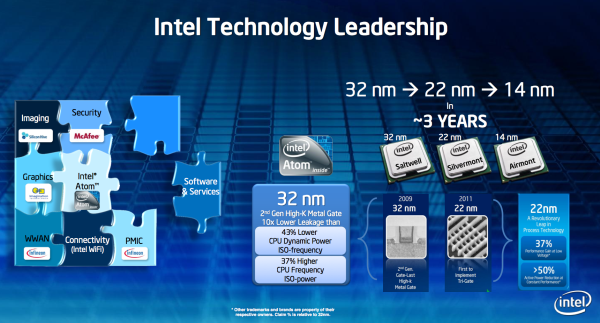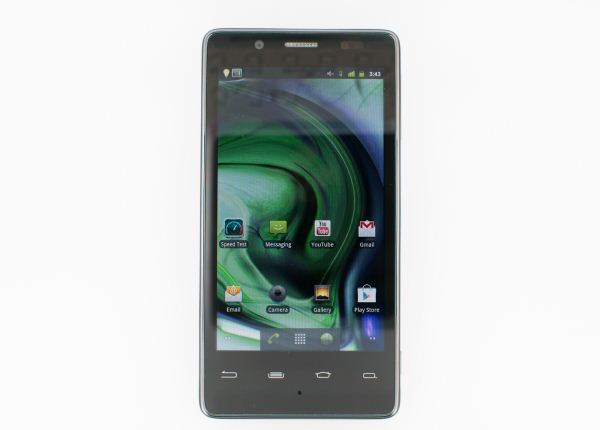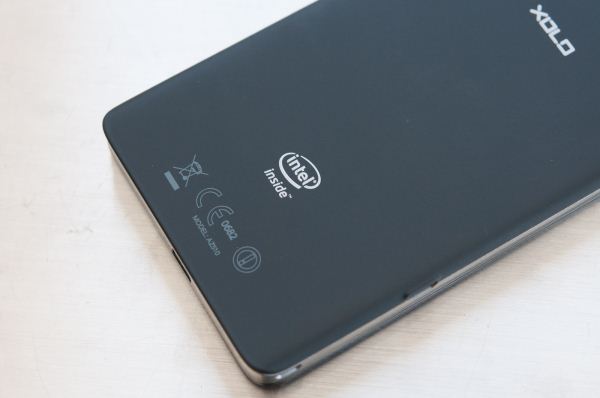Lava Xolo X900 Review - The First Intel Medfield Phone
by Brian Klug on April 25, 2012 6:00 AM ESTFor Intel, answering the looming ARM threat is obviously hugely important for the future, and it recognizes that - look no further than the restructuring of the Intel Architecture Group. The fire was lit with the impending arrival of Windows On ARM (WOA), at which point the line between traditional ARM-dominated smartphone/tablet SoCs and a real desktop class compute platform will start getting blurry, fast.
The other trend in the SoC space is slowly arranging all the pieces of the puzzle to truly deliver a complete System On Chip. In addition to CPU, GPU, and video encode/decode, those who will be the most successful and emerge as dominant players in the SoC space will need to bring baseband, GNSS, bluetooth, WLAN, and RF all onboard. Almost everyone gets that trend - Nvidia is adding baseband with Icera, Qualcomm has baseband and has added WLAN and Bluetooth with Atheros, Intel added baseband with Infineon and ISP with SiliconHive. Further, it has Gen graphics in the future for both GPU and video encode/decode. Look no further than the last slide of one of its slide decks and you'll see an illustration showing precisely what I'm talking about - pieces of the puzzle coming together.
We understand the motivation for building a smartphone SoC (computing is going even more mobile) and the integration necessary to get there (Intel owns a lot of IP blocks + Moore's Law), so how did Intel's first attempt fare? In short, reasonably well.
The Atom Z2460 in the X900 is a competent dual-core Cortex A9 competitor with competitive battery life and power draw, and no doubt Z2580 (its dual core, SGX544MP2 high end counterpart clearly targeted at Windows 8 platforms) will be equally as competitive against quad core A9s. If Intel's goal with both Medfield and the X900 was to establish a foothold in the smartphone SoC space and demonstrate that it can indeed deliver x86 in a smaller form factor and lower power profile than ever before then it truly is mission accomplished.
The x86 power myth is finally busted. While the X900 doesn't lead in battery life, it's competitive with the Galaxy S 2 and Galaxy Nexus. In terms of power efficiency, the phone is distinctly middle of the road - competitive with many of the OMAP 4 based devices on the market today. If you've been expecting the first x86 smartphone to end up at the bottom of every battery life chart, you'll be sorely disappointed.
There is however a big difference between middle of the road and industry leading, which is really the next step that we need to see from Intel. If Motorola is able to fit a 23% larger battery in a significantly thinner phone (Droid RAZR) then we need to see the same with Medfield. As Intel's major branded launch partner, we have high hopes that Motorola will deliver just that later this year.
The performance side is obviously even more competitive. Atom isn't always industry leading in our tests, but the X900 is rarely more than a couple places away from the top (with the exception of GPU performance of course, but that's a matter of licensing a different IP block in future versions). For a reference design that an Intel partner can just buy, barely customize, and ship - that's not bad at all. Smartphone vendors spend a considerable amount of time building phones that perform well - Intel's offer to internalize much of that can be either scary or amazing depending on who you're talking to.
There's always going to be room for design and software customization, but ultimately only those vendors who are good at those types of things will be able to survive if Intel's direct FFRD route succeeds. It's unsurprisingly very PC-like, where differentiation doesn't really happen at the motherboard level but rather at the system level. I can see both good and bad that could come of this, but the initial outcome should be positive. The results of this initial FFRD turned commercial device demonstrate that Intel is absolutely a competent system integrator itself, with an awesome display, camera, and other component choices.
The software compatibility story, like the concern over power consumption, is also a non-issue. The vast majority of apps we tried just worked, without any indication that we were running something intended for a different instruction set. There are still a few rough edges (e.g. Netflix), but if Intel is able to get things working this well at launch, the situation will only improve going forward.
Ultimately Intel's first smartphone is a foot in the door. It's what many said couldn't be done, and it's here now. What it isn't however is a flagship. To lead, Intel needs an updated Atom architecture, it needs to be on 22nm, and it needs a faster GPU - at a minimum. All of this needs to come in a reference design that's not just good enough, but better than the rest.
On the one hand it's a good thing that you can't tell an Intel smartphone apart from one running an ARM based SoC, on the other hand it does nothing to actually sell the Intel experience. Intel is never taken seriously in markets where it relies on being good enough, and it moves mountains in those where it's the best. That's what Intel needs to really build credibility in the smartphone space. A little was earned by getting this far, but its reputation will be made based on what happens next. There's obviously a strategy here, but I'm curious to see it unfold. Intel can be a fierce competitor in any space where it feels threatened. What I'm waiting for is that Conroe moment, but in a smartphone.
We waited years for Intel's first smartphone, now the question is how long do we have to wait for the first irresistable one?













106 Comments
View All Comments
diulaylomochohai - Thursday, April 26, 2012 - link
Where are the numbers for HTC 1X and 1S??? Let see how much INTC is off from latest and greatest from NVDA and QCOM???dwade123 - Friday, April 27, 2012 - link
Intel proves x86 can compete. With Intel's engineering and manufacturing advantages, Intel may soon surpass ARM in just about everything in the future. I still remember those who thinks ARM's transition to desktop is a threat to the entirety of Intel. Nope. It's the other way around. Intel is invading the low wattage CPU arena. Hate them or love them. The future is Intel.jwcalla - Friday, April 27, 2012 - link
I lol'd.jwcalla - Friday, April 27, 2012 - link
Apple just crapped out $12 billion in pure profit in just the last quarter. That's over 4x the profit that Intel saw, and Apple had almost 4x as much total revenue as Intel.The iCraze is in full song and Android is right up there with them. The masses don't care about x86 on a smartphone. And they're not going to. They want the iShiny. Only the dinosaurs that are hooked into these mythical "necessary" legacy x86 mobile apps are going to care about an Intel phone or tablet. And they're going to want them sporting a turbo button and USB-powered 5.25" floppy drive.
pheadland - Friday, April 27, 2012 - link
Small correction: I know Samsung says the GS2 only takes 32GB SD cards, but numerous people, including me, have 64GB SDXC cards working just fine in their GS2s (and many other Android phones).This trend to omit SD expansion and provide only 16GB built-in is puzzling and annoying. I have around 40GB of music. TV shows and movies can run multiple GB each. Streaming just doesn't cut it in rural areas or on planes.
phoenix_rizzen - Wednesday, May 2, 2012 - link
Have you put more than 32 GB of data on that 64 GB card, to make sure it's actually able to use all of it? Just curious, more than anything.Exophase - Friday, April 27, 2012 - link
In the article you say that the translations are taken from Intel's servers in order to avoid the overhead of doing it on the phone. I doubt this is true, because based on Intel's publications the translation in its current state isn't that sophisticated and unless it is very poorly coded there's no way it'd be slower to do it on the device than pull it off the network.I think the real reason they did this is so they can improve the translation quality w/o updating the phones. Part of this could include hand optimizing hot spots or fixing incompatibilities in some of the more problematic games. Maintaining a database of program specific modifications on every phone would not be a good move.
The article had some good information but I'm disappointed in the total lack of attention given to games. In the big list of apps that work fine I could only spot one game. For comparison, S|A tried two games - both worked, but one of them had awful performance. The phone game market is huge right now and it'd be nice to see someone try several - dozens, perhaps? - of games on the unit. But if they don't, the review should at least indicate that it's not focusing on it. With reviews like this it feels like phone gaming is almost completely devalued, which is bizarre given that several GPU benchmarks are performed, and GPU performance benefits little more than gaming.
Of course, the battery life tests also don't address gaming. The iPhone 4S review had at least one gaming test (for something really resource intensive) so it's not like there's zero precedent for it.
The big open questions for Intel putting x86 phones have never been if they can implement competitive GPUs or media blocks or even if they can have very low power consumption when there's low CPU activity. These things are obvious and Intel has already proven themselves on all of these fronts. What people want to know, or at least what I want to know, is what the power consumption is like when the CPU is being heavily accessed. In other words, I want an idea of perf/W. Talk time tests use a negligible amount of CPU. Browser tests use an unknown amount of CPU - it could be literally anything depending on what sites you use and how the idle parameters are tuned. I'd love to see some CPU utilization + frequency graphics during this test. But suffice it to say, if you're trying to simulate the user browser experience it'll consists of small periods of heavy activity while pages are loaded and vast periods of low activity while the user reads what's on the page.
This is totally different from at least a lot of games, where the CPU constantly has to do something. This both increases the average frequency it has to operate in and gives it less time to go from full idle to full activity.
At the very least it'd be nice to see some video playback battery tests. This (ideally) doesn't use much CPU either, and I'm sure Medfield does just fine here, but it's at least an important use case that should be validated. When you're on an airplane I'm sure you won't be using your phone for talking or web browsing.
kuroxp - Monday, May 21, 2012 - link
say sorry! see updates. :Dsjprg2 - Sunday, April 29, 2012 - link
Are all the cell phone makers STUPID? Where is the hands free bluetooth support with caller ID such as the Motorola V750 has? These are supposed to be phone! You can't drive in Califorina with the existing smartphones. They are not legal!derodg - Monday, May 7, 2012 - link
You people are forgetting one very important thing here. This is x86 device! I should in theory be able to run any x86 compatible OS. Which includes Windows 8 that has a touch interface. This means I could dock my phone to a larger display use a keyboard and mouse. Then pick it up an walk out the door and use the same device.And once they get dual-cores in the Atom. Not only can I just buy one app. I can use it on my desktop and mobile device because they both would be the same.